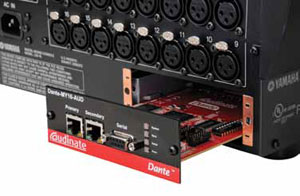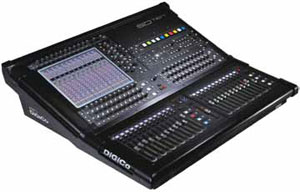The Need for Network

Outfitting Audio Consoles for the Current Digital Audio Networking Landscape
Yamaha’s Dante-MY16-AUD interface card
The market demand for digital audio networking and distribution systems for certain installation applications has grown over recent years, and many mixing console manufacturers have responded by increasing their interoperability options. The ability to remotely locate and share stage boxes between, say, the front of house and monitor desks already allows a degree of networking, of course, but for those applications requiring more complex distribution, console companies offer a variety of solutions.
Matt Larson, professional audio national sales manager for Group One/DiGiCo, noted that the MADI transport protocol in DiGiCo’s products already allows consoles to be linked over distances of 100 meters or more using good quality cable. A single- or multi-mode Optocore fiber optic system can increase that distance, as well as the networking capabilities.
“We have a two-gig optical network that allows us to have five consoles on the network with up to 14 racks. Each rack can be a 56 in by 56 out on the network. In a house of worship, I could have a front of house, a monitor, and a broadcast console, another console in another building such as a youth room, and another in, say, a small chapel,” Larson said.

MADI transport protocol in DiGiCo’s products already allows consoles to be linked over distances of 100 meters or more .
Soundcraft, too, has standardized on MADI , according to national sales manager Tom Der, and also offers provision for certain optional interface cards to be fitted, such as Aviom, CobraNet, and EtherSound. But the market demand for complex networks is still fairly small, he added, “I think partly due to cost, partly due to the complexity, and partly due to there not being a huge need. The customers that are interested in networks are typically either large performing arts centers or large churches.”
A daily selection of the top stories for AV integrators, resellers and consultants. Sign up below.
A Soundcraft system can already network a couple of desks via a shared remote stage box. “It’s when you get into three, four, or five different positions that need to be on the network that it becomes much more difficult, and a true audio network becomes more desirable,” Der observed. As for the proportion of customers that require such capabilities, “I’d say 20 to 30 percent at most need that sort of power of a true audio network, or are willing to deal with the IT backbone to implement it.”
“A lot of houses of worship are doing small network systems because they want to distribute to front of house, monitors, and broadcast,” confirmed Steve Seable, system design engineer with Yamaha Commercial Audio. “Plus, most churches do some sort of live streaming, so they need networking to get to the web, or they’re archiving information. So there’s usually a broadcast or recording element, and that requires a lot of distribution. And analog splits get pretty messy, the bigger they get.”
Yamaha’s consoles can operate with almost any available network and transport format. “I think we have the greatest interoperability between network formats of any company,” said Seable.
The company offers an assortment of optional MY interface cards. “There are about 40 different MY cards available for the consoles and the DSP and amplifiers,” he reported. Supported protocols include CobraNet, Audinate’s Dante, EtherSound, Riedel’s RockNet, Optocore, and Aviom’s A-Net 64. “Then there are the digital transports—MADI , ADAT, and we embed and de-embed SDI ,” Seable offered.
The market is in flux as far as which format is most popular, he continued. “In the past, most of the networking for installations has been CobraNet. I think that’s shifting, because there hasn’t been a lot of development on CobraNet in the last few years, so we’re seeing less of it.”
One format does enjoy Yamaha’s support more than the others, continued Seable: “We have more products with an EtherSound port on them than any other network. It’s easy, fast, and it’s got the lowest latency of any of the networks we have built in.” Most Nexo products also include an EtherSound port, he added.
DiGiCo offers Dante—which offers an eventual path to the AVB (Audio Video Bridging) standard—plus SDI , ADAT, and Aviom cards as options. The company’s Purple Box, a 1RU outboard converter, interfaces between the MADI output of any console—not just DiGiCo’s—and single- or multimode fiber systems, providing easy access to the benefits of those systems. For example, said Larson, “That allows me to shoot the MADI stream much further throughout a facility.”
“Our great hope is that AVB will become the universal glue that holds us all together,” Der said. As a potential standard for the consumer and video markets and not just for the pro audio market, AVB could become ubiquitous, he remarked—assuming it lives up to its promise. “It holds the greatest hope, in my view, of getting away from all these networking ghettos. The issue is that AVB development has continued to drag out; it’s not happening as quick as I would like.”
Steve Harvey (psnpost@nbmedia.com) has been west coast editor for Pro Sound News since 2000 and also contributes to TV Technology and Pro Audio Review. He has 30 years of hands-on experience with a wide range of audio production technologies.
